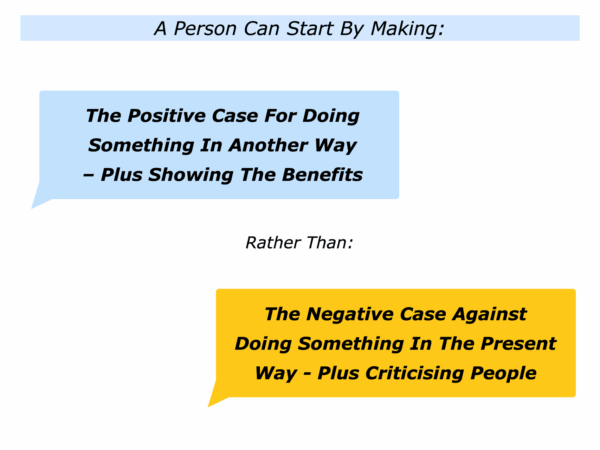
There are many ways to present ideas to people, organisations and the wider society. One approach is to:
Start by making the positive case for doing something in another way and also show the benefits.
Such an approach is different from that which many people have learned in academia and elsewhere. They were then taught to:
Start by making the negative case against the present way of doing something and, by implication, sometimes criticise other people.
The positive case approach recognises that people buy benefits. People are more likely to do something if they can see how it will benefit them and, in some cases, other people.
This approach is also more likely to generate positive energy and openness to possibilities. It encourages people to continue to develop and achieve certain goals.
Starting by making the negative case against the present way of doing something can generate negative energy. It can also come across as critical and lead to people closing down.
People Can Follow The Positive
Case Approach In Different Situations
A manager can present the positive case for doing something when meeting with key decision makers in a company. They can describe the potential way forward rather than simply criticise existing procedures.
They can also present the benefits for the various stakeholders. For example, how it may help to improve the company’s profits, service to customers or morale for the colleagues.
An educator, therapist or advisor may – when appropriate – present the positive case for doing something when helping a person to see a possible way forwards. It can be important to bear in mind the following themes.

People who follow this approach may need to come across as realistic rather than starry-eyed optimists. Bearing this in mind, they may also do something that sounds paradoxical.
The person can present the potential pluses of doing something and, when appropriate, also present the potential minuses.
They can present the specific things that can be done to build on the pluses and manage the consequences of any minuses.
This sounds odd but – when done properly – it can sometimes strengthen the case.
Finally, a person can only do their best when presenting the positive case for doing something. The reality is that it may then be up to the decision makers to decide if they want to follow this route.
Looking ahead, can you think of a situation where you may want to follow elements of the positive case approach? If you wish, try tackling the exercise on this theme.



Leave a Reply